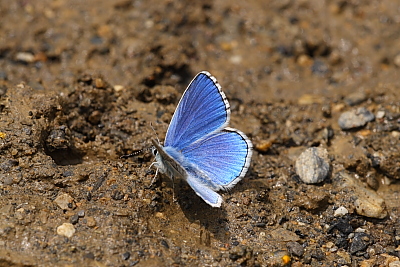
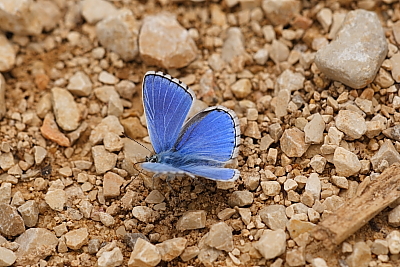
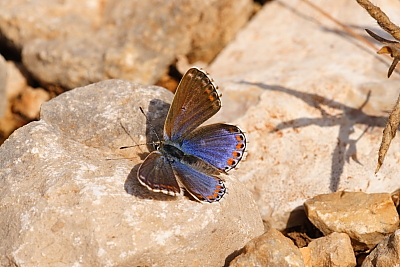
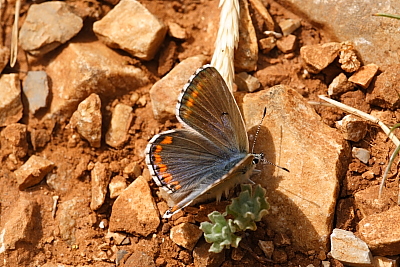


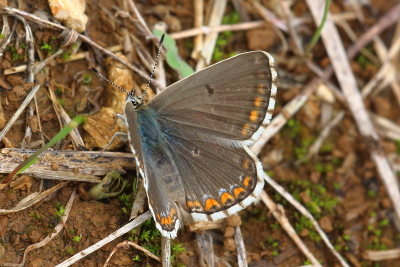
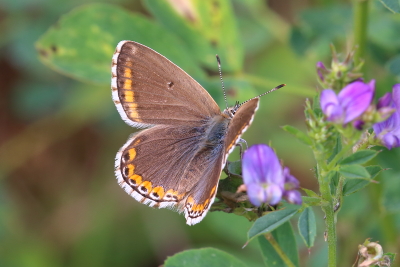
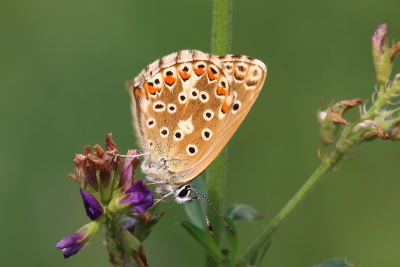
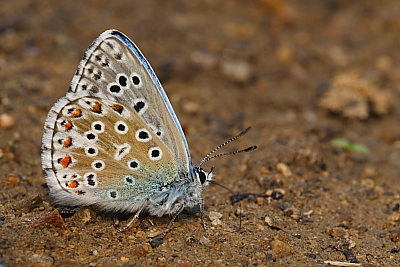






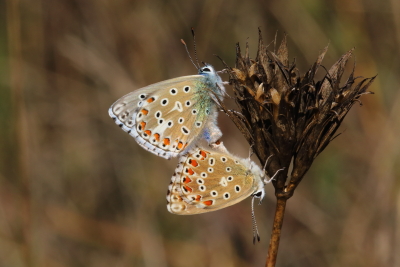
Adonis Blue (Polyommatus bellargus)
2025 photographs highlighted in green. Click on any photograph to go to an enlarged picture, or simply scroll down the page.
|
A species with restricted range in the UK, but occurring in nearly every French département, sometimes very common, and often found where the larval hostplant Horseshoe Vetch (Hippocrepis comosa) grows. It is slightly larger than the Common Blue (P. icarus) with which it is most likely to be confused, at least on a frequency basis. The male upperside is a very distinctive bright blue, often discernible in flight, with the characteristic black chequering on the white margins where the veins cut the margin. There are occasionally black spots in the marginal areas of the uph; there is a species known as the Spotted Adonis Blue (P. punctifera) but this does not occur in France.
The female upperside is basically brown, as with most blues, but it has varying amounts of blue according to locality. Generally (but with exceptions) in my experience the female is plain brown at low altitudes but with increasing amounts of blue as the altitude increases, with a very blue form known as ceronus and intermediary forms which could perhaps be described as semi-ceronus.
There is also the female form known as coelestis which occurs in the west of France, mainly in the département of Deux-Sèvres where the blue reaches the margins, and it is said that in ceronus the blue does not reach the margins. The butterfly Atlas of the region of Poitou-Charente states that coelestis can reach 20% of the female population of the second generation. |
However, some authorities consider ceronus and coelestis to be synonymous, and they may have a point: in 14415 the blue clearly reaches the margins of the hindwing and 42810 looks to all the world to match the description of coelestis. Thanks to Adriaan van Os for bring the coelestis form to my notice.
The underside is superficially similar to icarus, especially as bellargus has a unf cell spot which many Polyommatus species do not have. The male underside ground colour can vary from grey to pale brown, especially the unh, and the female is usually a deeper but more consistent brown.
Bellargus is actually related to the Chalk-hill Blue (P. coridon) which becomes more apparent on comparison of the underside patterns. The normal brown form of the female can be very similar, sometimes almost indistinguishable, from the female coridon.
This species was originally known as Lysandra bellargus. In 2010 it was reclassified as Polyommatus bellargus and in 2017 it was again reclassified back to Lysandra bellargus. I'll give it a few years before changing the web page (and all the occurrences and links associated) as it is entirely possible that the taxonomists will change it again. |
| ref | sex |
observations |
alt. m |
| 21694 | M |
quite lightly chequered fringes. |
1400 |
| 35486 | M | a male, quite fresh and showing the strong bright blue which makes bellargus almost identifiable in flight. The chequering of the fringes is also strong. | 780 |
| 14415 | F |
a female with almost completely blue hindwings, with the orange lunules merging into the blue. |
780 |
| 5908 | F |
a fabulously marked female, with a full set of orange uph lunules and even a reasonable set on the upf. There is a smattering of blue scales, most pronounced at the outer edges of the uph lunules. The female is quite variable, usually plain brown, 5908 being quite strongly marked compared to the norm. |
780 |
| 14290 | F |
another delicately marked female, with blue scales setting off the strong hindwing lunules. |
220 |
| 42810 | PAIR | a mating pair, the female on the left. The female is unlike any that I have ever seen before. It has extensive and rather streaky blue on the upf and a full set of very large orange lunules on the uph. | 220 |
| 54277 | F | a typical female. | 280 |
| 54289 | F | a female with a little more white showing in the uph marginal lunules and stronger orange in the upf submarginal area. | 280 |
| 54246 | M | a male, confirmed in flight, and showing that the unh brown ground colour can be quite typical for males. | 280 |
| 15421 | M |
a typical male underside, with clear contrast in the brown ground colour of the unh and the grey of the unf. |
220 |
| 13928 | M |
a male, with rather browner colouring, especially the hindwing, fairly typical. |
185 |
| 34359 | M | a very crisply marked male, taking salts from the ashes of a bonfire. | 220 |
| 50240 | M | a very fresh male, with a strong brown ground colour, rather unusual for a male. | 320 |
| 42180 | F | a female, with a rather greyer unf ground colour than normal for females from this part of the world. | 220 |
| 37133 | PAIR | a mating pair, the female on the right, with a browner ground colour and slightly larger. The male looks quite fresh. | 185 |
| 9395 | F |
this female has a fairly standard deep brown underside ground colour, particularly on the unh, contrasting well with the bright orange lunules. |
780 |
| 53351 | PAIR | a mating pair, the male above. The ground colour of the male is a rather pale brown. | 220 |
21694_male_Alpes-Maritimes_7Jul10
54277_female_Côte-d'Or_30Aug25
54289_female_Côte-d'Or_30Aug25